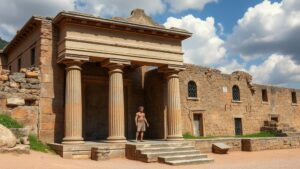Exploring the remote plateaus of Bolivia for evidence of Tiwanaku outposts.
Exploring the Remote Plateaus of Bolivia for Evidence of Tiwanaku Outposts
The remote plateaus of Bolivia, particularly in the region surrounding Lake Titicaca, are not only breathtaking in their natural beauty but also rich with archaeological significance. These high-altitude areas were once the cradle of the Tiwanaku civilization, which thrived between 300 AD and 1000 AD. As researchers and historians delve into the enigmatic remnants of this society, they are increasingly turning their attention to potential outposts scattered across these plateaus. This article seeks to explore the significance of these outposts, their connections to the central Tiwanaku site, and the ongoing efforts to uncover their mysteries.
The Tiwanaku Civilization: An Overview
The Tiwanaku civilization is one of the oldest and most significant cultures in the Andean region. Located near the southern shore of Lake Titicaca, the Tiwanaku site demonstrates advanced architectural and agricultural practices, which were pivotal to their success. Key features of the Tiwanaku culture include:
- Innovative agricultural techniques, such as raised field farming
- Remarkable stone constructions, including the Akapana Pyramid and the Gateway of the Sun
- A complex social structure, with evidence suggesting a stratified society
By the time the Tiwanaku collapsed, it had a profound impact on subsequent cultures, notably the Inca. But, the extent of their influence and the reach of their outposts remain subjects of ongoing research.
The Importance of Remote Outposts
Recent archaeological studies suggest that the Tiwanaku civilization established various outposts throughout the plateaus of Bolivia to regulate trade, maintain political control, and foster agricultural expansion. These remote sites are crucial for understanding the extent of Tiwanaku influence and their adaptability to diverse environments.
Outposts may have served several essential functions:
- Trade Hubs: Positioned along key trade routes, these outposts facilitated the exchange of goods such as textiles, ceramics, and agricultural products.
- Cultural Exchange: They hosted interactions with neighboring cultures, allowing for the exchange of ideas and technologies.
- Military Surveillance: Strategically located, these outposts enabled the Tiwanaku to monitor and control their territories effectively.
Recent Discoveries and Research Methods
Archaeological expeditions over the past few decades have revealed numerous sites on the remote plateaus, providing concrete evidence of Tiwanaku outposts. Notably, researchers have utilized advanced methodologies including:
- Remote Sensing Technology: Techniques such as LiDAR (Light Detection and Ranging) allow researchers to identify and map previously obscured structures beneath dense vegetation.
- Geospatial Analysis: Geographic Information Systems (GIS) help assess the distribution and relationship of these outposts concerning the Tiwanaku core area.
- Excavation and Material Analysis: Excavating these sites provides insights into the materials used, everyday life, and the economic activities of the Tiwanaku.
For example, a project led by the University of California at Los Angeles uncovered artifacts in outposts that mirrored those found at the main Tiwanaku site, indicating a strong cultural link.
The Challenges of Studying Remote Areas
Exploring the remote plateaus presents several challenges for researchers. Some of these hurdles include:
- Geographical Obstacles: The rugged terrain and high altitude can complicate access and logistics for archaeological teams.
- Environmental Conditions: Harsh weather patterns, including strong winds and significant temperature fluctuations, can hinder excavation and preservation efforts.
- Cultural Sensitivity: Engaging local communities respectfully is vital, especially since many modern inhabitants may have ancestral ties to the Tiwanaku civilization.
Conclusion: Uncovering Tiwanakus Legacy
Exploring the remote plateaus of Bolivia for evidence of Tiwanaku outposts provides invaluable insights into one of ancient South America’s most accomplished civilizations. As researchers piece together the puzzle of Tiwanaku’s expansion and influence, these outposts serve as crucial links to understanding their legacy. The combination of innovative technology and traditional archaeological practices fosters a more comprehensive view of how the Tiwanaku impacted the region’s history.
For those interested in archaeological travel, visiting these remote plateaus could provide a firsthand look at significant historical sites and ongoing research, allowing for a deeper appreciation of this ancient civilizations achievements and influence.



